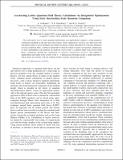| dc.contributor.author | Avkhadiev, Artur Ramisovich | |
| dc.contributor.author | Shanahan, Phiala | |
| dc.contributor.author | Young, R. D. | |
| dc.date.accessioned | 2020-05-06T14:41:17Z | |
| dc.date.available | 2020-05-06T14:41:17Z | |
| dc.date.issued | 2020-02-26 | |
| dc.date.submitted | 2019-08 | |
| dc.identifier.issn | 1079-7114 | |
| dc.identifier.issn | 0031-9007 | |
| dc.identifier.uri | https://hdl.handle.net/1721.1/125042 | |
| dc.description.abstract | The only known way to study quantum field theories in nonperturbative regimes is using numerical calculations regulated on discrete space-time lattices. Such computations, however, are often faced with exponential signal-to-noise challenges that render key physics studies untenable even with next generation classical computing. Here, a method is presented by which the output of small-scale quantum computations on noisy intermediate-scale quantum era hardware can be used to accelerate larger-scale classical field theory calculations through the construction of optimized interpolating operators. The method is implemented and studied in the context of the 1+1-dimensional Schwinger model, a simple field theory which shares key features with the standard model of nuclear and particle physics. ©2020 | en_US |
| dc.description.sponsorship | U.S. Department of Energy, Office of Science, Office of Nuclear Physics (grant no. DE-SC0011090) | en_US |
| dc.description.sponsorship | National Science Foundation CAREER (grant no. 1841699) | en_US |
| dc.publisher | American Physical Society | en_US |
| dc.relation.isversionof | 10.1103/PhysRevLett.124.080501 | en_US |
| dc.rights | Creative Commons Attribution 3.0 unported license | en_US |
| dc.rights.uri | http://creativecommons.org/licenses/by/3.0 | en_US |
| dc.source | American Physical Society | en_US |
| dc.title | Accelerating lattice quantum field theory calculations via interpolator optimization using noisy intermediate-scale quantum computing | en_US |
| dc.type | Article | en_US |
| dc.identifier.citation | Avkhadiev, A., P.E. Shanahan, and R.D. Young, "Accelerating lattice quantum field theory calculations via interpolator optimization using noisy intermediate-scale quantum computing." Physical Review Letters 124 (Aug. 2020): no. 080501 doi 10.1103/PhysRevLett.124.080501 ©2020 Author(s) | en_US |
| dc.contributor.department | Massachusetts Institute of Technology. Center for Theoretical Physics | en_US |
| dc.relation.journal | Physical Review Letters | en_US |
| dc.eprint.version | Final published version | en_US |
| dc.type.uri | http://purl.org/eprint/type/JournalArticle | en_US |
| eprint.status | http://purl.org/eprint/status/PeerReviewed | en_US |
| dc.date.updated | 2020-02-26T15:35:05Z | |
| dc.language.rfc3066 | en | |
| dspace.date.submission | 2020-02-26T15:35:04Z | |
| mit.journal.volume | 124 | en_US |
| mit.license | PUBLISHER_CC | |
| mit.metadata.status | Complete | |
